If you click a picture it will be enlarged. The pictures can then be viewed in succession as a slideshow. If you see a link, for example: Shigatse Travels click on the link and it will be opened. When referring to a map, the map can be accessed by clicking on the link : (route)map of Tibet . The clips (images with an arrow) that are included are HD recordings. The clips can be viewed in a separate window that automatically opens when you click on the image with the arrow.
English is not our native language, so we apologize in advance for translation- spelling- and grammar errors.
(route map) Fortunately Ingrid feels a lot better today. Important because a nice trip to Namtso (4700 m) is scheduled for today.
Namtso is located about 220 km north of Lhasa. Not a huge distance. Nevertheless it will take a six hour drive to get there. Despite the excellent road conditions you are only allowed to drive a maximum speed of 40 to 60 km an hour.
For each part of the journey you have to fetch a ticket that says how long you should do to make the next section (for example 39 km in 45 minutes). If you arrive early at the next police station, you get a fine because you have driven too fast. Instead, if you arrive late at the station you will get a fine too because you must have stopped unauthorized for to long along the way. Section control for sure must have been a Chinese invention.
Passang and driver have to identify themselves every time and again and our permits are also checked incessantly! As a tourist you are not that much affected by it because the guide does all the paperwork but it confronts you time and time that China made the beautiful Tibet into a police state. And that hurts.
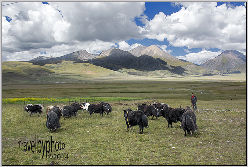
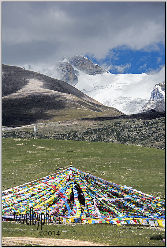
The trip through a beautiful deserted mountain scenery is amazing! However, the landscape is criss-crossed ruthlessly by the railway from Lhasa to Beijing. We spot this highest train in the world a several times.
We have lunch in a small local restaurant in Damxung. Delicious noodles.
We cross the Laeken La pass at 5150m. Very different here than in Ladakh. Here no deep ravines and roads full of hairpin turns, but neat asphalt roads on a plateau. Fine weather today. Occasionally threatening clouds, but no drop of rain is fallen. On top of the pass we have a first panoramic view on Lake Namsto. Wow really impressive.
Once "down" we drive to Namtso lake. On the plateau, we see many Dropka tents. The Dropka are Tibetan nomads who camp here in summer to let their herds of yaks and sheep grazing.
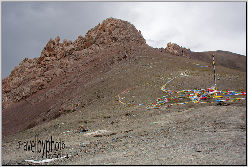
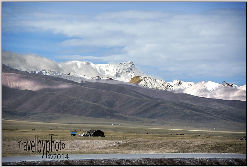 At five o'clock p.m. we arrive at Namtso. There are little accommodation options near the lake so we are glad that we have a sleeping place in the Namsto Holy Lake Questhouse. There is a large lobby / canteen - very cozy - where you can eat. Our rooms are not in the main building but a bit further on the complex in a shack. The rooms are very simple. Looks a little like a Barak: thin dividing walls, no running water and no toilet.
At five o'clock p.m. we arrive at Namtso. There are little accommodation options near the lake so we are glad that we have a sleeping place in the Namsto Holy Lake Questhouse. There is a large lobby / canteen - very cozy - where you can eat. Our rooms are not in the main building but a bit further on the complex in a shack. The rooms are very simple. Looks a little like a Barak: thin dividing walls, no running water and no toilet.
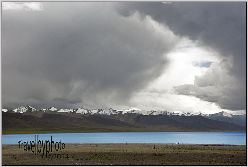
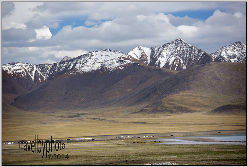
The toilet is on the other side of the site. Very special toilets, incidentally; the droppings are collected in a double plastic strip which then closes and is drawn vacuum. Turds packed as sausages! However clever as water is scarcity and a sewer is difficult to construct in rocky territory.
We walk along the lakeshore. In Tibetan Namtso Lake means 'Heavenly' Lake. "The purity of the lake symbolizes the innocence of the Tibetan Plateau. Namsto is a saltwater lake and is considered one of the three holy lakes in Tibet. The views over the blue water and the white mountain peaks in the background is really breathtaking. Some mountains of the Tangula Mountains range exceed 7000m.
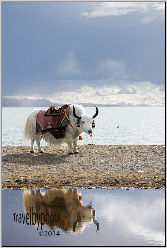
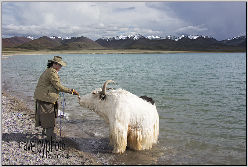
Namsto is also a place of pilgrimage, but there are only a few pilgrims today.
Near the water are some impressive white yaks. The yaks are nicely washed in the lake. In small tents - protected from the wind that blows here - artists are painting mantras on stones.
In the evening we have a tasty meal in the restaurant Namsto Holy Lake Quest House.
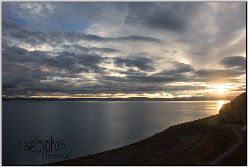
Ingrid didn't sleep well tonight. It seems that she is the person that is most affected by the altitude. She doesn't have her breathing completely under control and has a headache. Jan-Arend is not affected by the altitude but suffers from restless legs. Yesterday he got something for the ailment in a pharmacy. The ointment smells really bad and .... it does not help.
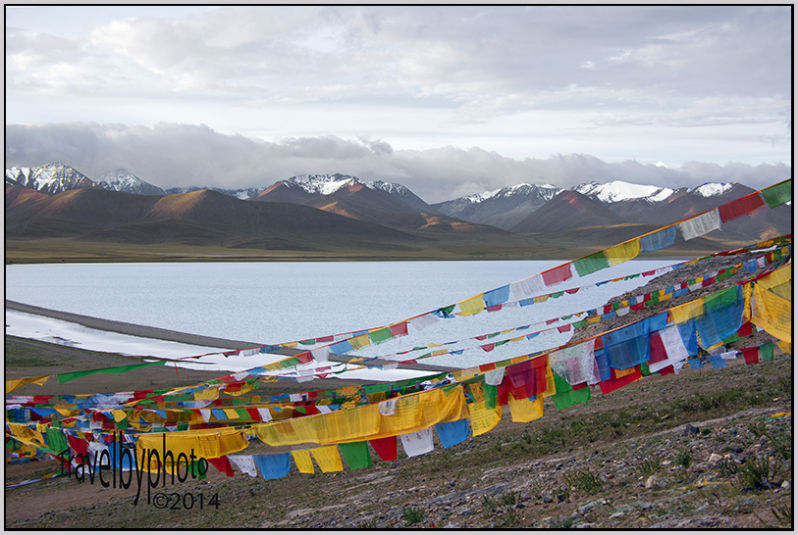
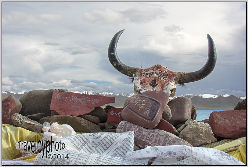
Early in the morning Jan-Arend walks to the lake for photographing and filming the sunrise. He climbed a mountain which was very strenuous! The light was disappointing so it was not special enough for much photographing and filming. No problem, the more time stays at liberty to relax and enjoy this very special place and unique views. Colored flags everywhere. Pierre and Dita walk around too.
After breakfast, the light begins to shine and we still have a lot of pictures and movies taken at the lake. The mountains lie nicely in the sun and the water is turquoise blue. Truly a picture!
After our morning walk we get into the car for the journey back to Lhasa. En route we drink butter tea as guests of a Dopka family. The tent in which they live consists of one chamber. The tent itself for sure is made of traditional canvas, but there is, surprisingly, a kind of Formica house with a real door and windows hidden under the tent.
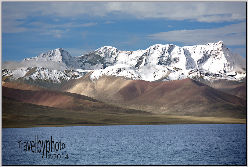
The family resides throughout the summer in the tent. In the winter they break up and return to their village. The tent is a nice mess. The food is simmering on the stove. You would not expect it, but some nomadic families here are very rich. They sometimes have hundreds of yaks and sheep, and their country have become much more valuable with the arrival of the Chinese. It is a nice stop. The reception is very hearty and hospitable.
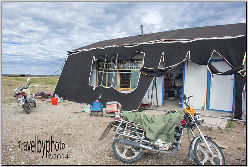
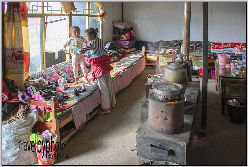
We continue our way through the tundra. The landscape is impressive. Many different colors of green and yellow. Many mosses. Trees do not grow here. Everywhere you look are boulders and flowing rivers.
Our driver has a really bad day today. He swings the car from left to right across the road. Quite frightening. He speaks no English. Therefore we speak to Passang about the driving behavior of the driver. The driver appears to be very ill.
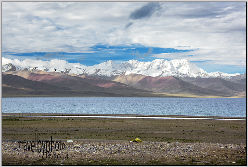
Passang has no driving license himself and for us as foreigners is strictly forbidden to take over the steering wheel in Tibet . A lousy situation, for the driver of course, but also for us. It's just not safe! His condition must be improved tomorrow otherwise it is really no longer responsible to drive with him in the car.
We cancel a planned visit to Tsurphu monastery. It would be necessary to drive an extra 60 km to get there and we don't think that is a good plan regarding our sick driver. We know how important the job is to him and we will give him every chance. The sooner he's in Lhasa the sooner he can go to his bed and the more chance there is that his condition will improve. We really hope it will be possible to continue our journey to Gyantse tomorrow with him as our driver.
Around 3 pm we arrive unscathed in Lhasa. We immerse ourselves among the hustle and bustle of Barhor again. The pilgrims still walk their kora. And then suddenly the modern times penetrates as a pilgrim in prayer kneeling on the ground pulls out his phone because he is called ...!
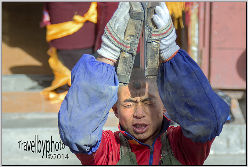
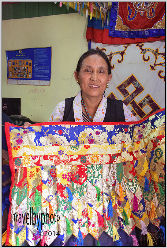
Actually we find that fun, that mix of old and new!
We have a drink In a very old pub which was once an inn for pilgrims. Ingrid buys a beautiful patchwork bag and some decorations for at home. We say goodbye to Lhasa and go back to the hotel where the four of us drink a nice glass of wine with French fries as an appetizer.
There have been a lot of clouds today, but only one minute rain. Furthermore, lots of sun, and warm!
The driver received medication from the doctor and says he is fully fit again.
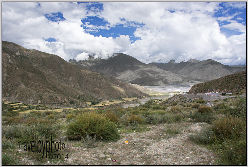
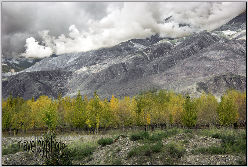
Today marks the starting point of our unique tour through Tibet. We follow the so called Friendship Highway all the way to Kathmandu (Nepal). At 9 am we leave our hotel in Lhasa for a drive towards the Yamdrok-Tsomeer. We drive three big mountain passes today.
At just another police control Dita and Ingrid take the opportunity to make a little walk into the fields. They take some pictures of trees that are partly in the water. The trees have beautiful autumn colors. Red and yellow.
We really have to climb the mountains now. Many hairpins. The road rises towards Kamba La (4800 m). From here you have a beautiful view. The only condition to enjoy the view is that the Chinese tourists give us some room! There are a lot of Chinese tourists in Tibet and they all want to make pictures with themselves in crazy poses in front. So the most beautiful places are always blocked by Chinese visitors waving with their arms and pretending to be divas. Usually they also stab two fingers in the air. Strange!
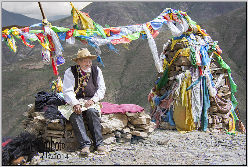
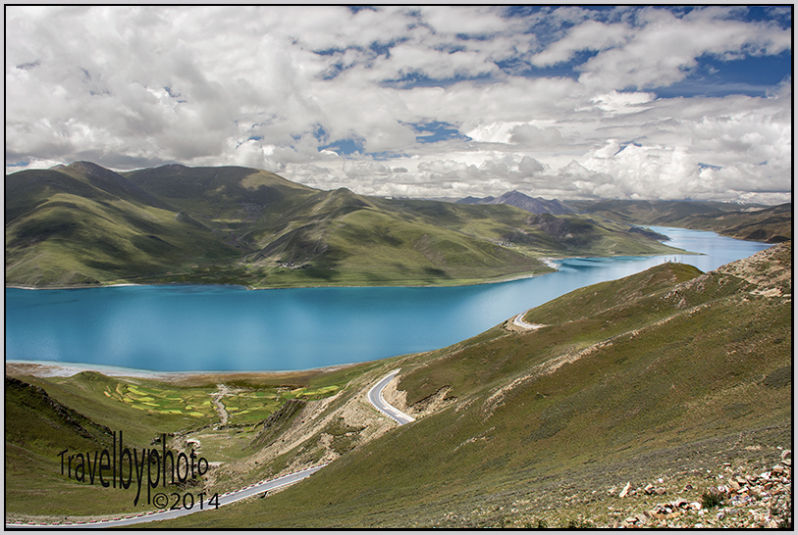
At the places we stop we see people with yaks and dogs with a collar of yak wool that look like bears. For money you can take a picture of them, but we do not need it. Everywhere prayer flags again of course!
The sun is almost always shining, but Sometimes suddenly clouds appear, it gets very dark and there is a hailstorm for minute or two. The weather can change very rapidly here so high in the mountains.
Then we get our first glimpse of lake Yamdrok Tso. Beautiful! Yamdrok Tso lake is a sacred lake. For the Tibetans Yamdrok Tso (Tso means lake) is place of pilgrimage. They believe that the lake is a transformation of one or more goddesses. Yamdrok Lake is situated at 4400 meters. It is the highest freshwater lake in the world. The many protrusions reminiscent of the claws of a scorpion. Thereby Yamdrok-Tso is also called scorpion lake. We stop at various places along the lake.
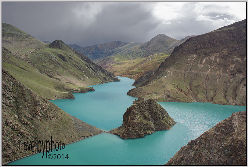
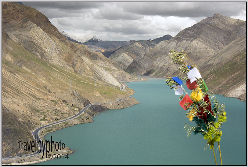
The lake has a very beautiful color, but there are also concerns about the lake. According to an old saying Tibet will no longer habitable if the lake would fall dry. So it is with great fear that the Tibetans notice that the water level in the lake drops because the Chinese are using the water for the turbines of a hydroelectric plant.
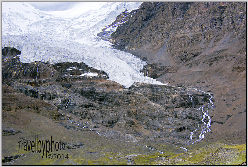
As visitors you only see the beauty of the lake and the nature and we really enjoy the view. It is a fascinating place.
After our visit to the lake we drive to Gyantse. Along the way here and there a small village. High snow capped mountains, a landscape of downed glacier stones, barren mountains and rocks with erosion. A particularly beautiful and fascinating journey.
At six o'clock we arrive in Gyantse. We stay at the Yeti Hotel. In the evening it begins to rain.
8:00 am breakfast.
It's pouring rain. Our plan was to visit the Gyantse monastery this morning but Ingrid does not fancy to leave the hotel because of the rain. Jan-Arend therefore starts out on his own to explore the city. He visits a market where a lot of pig heads and Yak ass pieces with tails still attached to it are showcased at the stalls. Bit lugubrious maybe but it shows once again that specific eating habits in a country can best be discovered on the local markets. In North-East India many insects were on the menu. In Tibet it is Yak meat they eat.
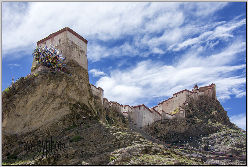
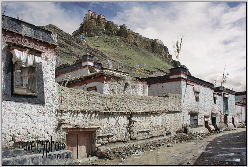
The others have a nice quiet morning in the hotel. The weather improves, it has become dry. After lunch we decide to skip a visit to the fortress and the monastery and go for a visit to the old town.
We try to explain our plan to Passang but he can't believe that we want to skip the monastery. Well, it is impossible to visit every hotspot in Tibet. There are many and there will be many more other monasteries to visit on our program schedule. So for now the only thing we want is to have some extra time to wander through the old town and experience common life in Tibet. The sun is shining fully. The bad weather this morning however has changed the small mostly unpaved streets in the old city into quagmires.
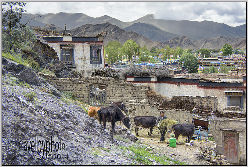
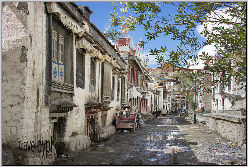 Many old white typical Tibetan houses, cows at the door, the walls pasted with manure with marks of handprints in it, small temples. Totally awesome.
Many old white typical Tibetan houses, cows at the door, the walls pasted with manure with marks of handprints in it, small temples. Totally awesome.
One side the old quarter is overlooked by the dzong (fortress) at the other side of the old quarter there you see the beautiful massive mountains get getting increasingly visible at the horizon. This is life as we think it used to be in many other places in old Tibet. Here, no noisy Chinese slogans. We walk around for a while with the five of us. Then we split. We stay a bit longer in order to enjoy the charming streets a bit more.
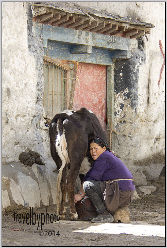
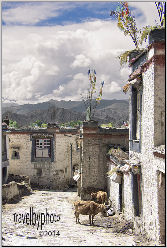
We have a nice walk through the mud; cow dung and over rocks. Eventually we end up at the gates of the monastery. At the market stalls in the square in front of the monastery we buy some cute little souvenirs to take home. Then we stroll back to the hotel.
A wonderful afternoon so. At the hotel Pierre and Dita invite to come and drink some wine. We accept the invitation gladly. Cozy, chat with wine, crisps and nuts.
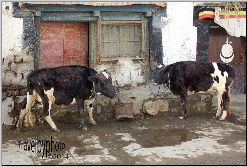
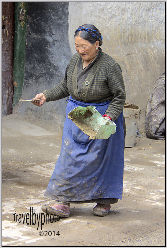 Around 7.00 pm we leave for the Tashi restaurant. We are served by a very friendly waitress. She comes from Lhasa and is only for the summer season here. We have a very tasty meal.
Around 7.00 pm we leave for the Tashi restaurant. We are served by a very friendly waitress. She comes from Lhasa and is only for the summer season here. We have a very tasty meal.
Back at the hotel we write and send some WhatsApp messages to home. We enjoyed our stay in Gyantse. It a very nice place.
Tomorrow we leave for Shigatse.
Departure from Gyantse. It is a 93 km ride to Shigatse, on a straight road. However, en route we are againconfronted with the many well known time / arrival regulations; of course. The road is very good.
Everywhere in Tibet where we travel the infrastructure is from remarkably high quality. The road- , water- and electricity facilities are good and even internet is almost anywhere available; though the Chinese have blocked access to a lot portals that we normally use like Google and Facebook. WhatsApp is not blocked.
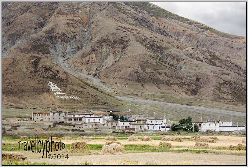
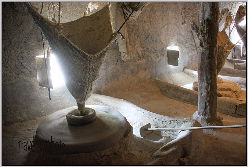
Our first stop today is at flour mill where the barley grain is grinded very fine with a water-powered mill. The flour is used in special ceremonies. The whole building is cloaked in a cloud of fine dust! Everything was covered, but it was very nice to see.
Today's route runs through an important agricultural area in Central Tibet. Everywhere people are busy on the land. We indicate that we want to stop near a field where people are at work, and that's what we do. It's a long climb from the road to the country, but it's worth it.
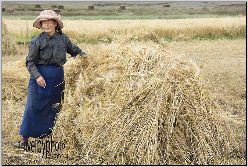
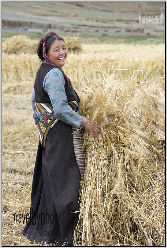
In the field people are busy mowing the corn. The corn in this region is from high quality. At first the farmers look at us as if we are aliens, but soon the ice is broken and everyone has lots of fun.
Everyone is proud when we take pictures. Too bad that we can not send the photos to the people, but according to our guide that is really not possible. A small village is situated beautifully at the foot of the mountains. Dita and Ingrid help the farmers a bit with collecting the sheaves of wheat.
Our next stop is the Shalu Monastery. The Shalu Monastery is a perfect combination of Han and Tibetan architectural styles. It was built in 1087 by Jigzun Xerab Qoinnyai.
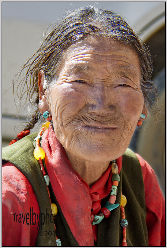
Shalu Monastery has four religious treasures. The 1st is a sutra board of 700 years. A passage from the sutra is printed on the board that is supposed to bring good luck. The 2nd is a holy pot made of brass. It is covered and closed by a piece of the red cloth. The water in the pot would be the purest water possible. The water can cure 108 kinds of diseases. The 3rd is a stone tablet engraved with 6 characters. The edge is engraved with four delicate small pagodas, which were excavated during the construction of the monastery. The 4th treasure is a huge stone basin. The basin would not overflow even on the rainiest day. The Living Buddha Jigzun Xerab Qoinnyai that Shalu monastery built always washed his face in the stone basin.
The monastery is not very big. Beautiful light. Too bad we are not allowed to take pictures. In front of the monastery sits a cozy group of women together. They clean hundreds of oil lamps of the monastery. We see countless oil lamps burning in all the monasteries that we visit.
We reach Shigatse (3900 m) smoothly and without problems. We have a beautiful hotel Shigatse KD Manasarovar hotel, with wifi (not working today).
In the afternoon Passang accompanies us in search of a shop where they can make us some clothes. Such a store is not found.
Ingrid has already decent hearing loss in her left ear for the last four weeks, but now her ear really hurts. She wants to visit a pharmacy where Dr. Dita may look with an otoscope in her ear, but no one has an otoscope and nobody speaks anything resembling English. Eventually we find a health shop-cum-pharmacy nearby the hotel. In the shop is a woman in a white coat. She looks like a doctor. After the necessary sign language she examines Ingrid's ear. She uses her i phone (!) as lighting device. She cleans the ear neatly. With gloves and sterile syringe and needle.
Ingrid was afraid that she was going to pierce her eardrum, but she puts a kind of hydrogen peroxide in the ear. She bustles the ear out. Finally she does antibiotic drops in the ear. Ingrid has to repeat this treatment the next days. The doctor gives her the necessary syringes, swabs and drops for the cure. All with Chinese reference marks naturally.
Everyone has slept well. Comfy beds too. Because it is raining at breakfast time we decide to leave a little later for our visit to the Tashihunpo monastery. Tashilhunpo (mountain of glory) once was the seat of the Panchen Lama. The monastery is founded in 1447. 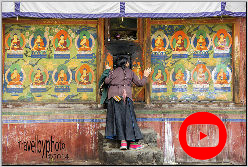
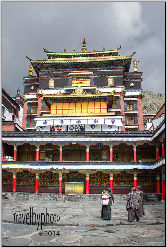
It is a beautiful and imposing monastery which consists of many buildings. Within photographing is excessive expensive; Photos 7.50 euro each (!), and film costs 180 euro. Well, it make it easy to decide; no interior pictures today.
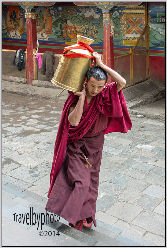
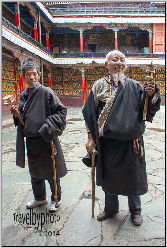 Not to worry; outside is very beautiful too. There it's okay to take pictures, and there is much to see. On the large courtyard pilgrims are forming a queue in front of a hole in the wall. The pilgrims hold their ear against the hole. So do we. We hear nothing but it should bring happiness and that of course is always good. The walls of the courtyard are beautifully painted.
Not to worry; outside is very beautiful too. There it's okay to take pictures, and there is much to see. On the large courtyard pilgrims are forming a queue in front of a hole in the wall. The pilgrims hold their ear against the hole. So do we. We hear nothing but it should bring happiness and that of course is always good. The walls of the courtyard are beautifully painted.
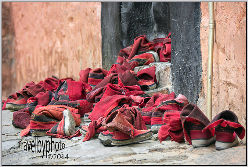
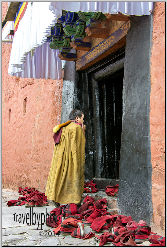
The main buildings can be identified by the golden roofs. From one of the temples monks come out with empty-copper water jugs on their backs. They fill the jugs with water from the waterpump and go back inside. Inside the temple, we can not discover where all that water is used for, but it's a cute face. There are a lot of pilgrims and we also see many monks with yellow caps and capes. They are dressed in ceremonial clothes and on their way from the living quarters to the temple for a service.
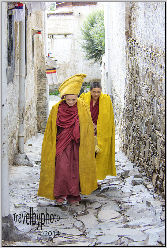
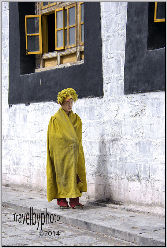 Almost all the monks wear traditional red slippers. When entering a temple you have to put out your shoes. No wonder that we see a huge mountain in front of the temple where the ceremony is held of red fabric slippers.
Almost all the monks wear traditional red slippers. When entering a temple you have to put out your shoes. No wonder that we see a huge mountain in front of the temple where the ceremony is held of red fabric slippers.
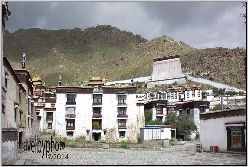
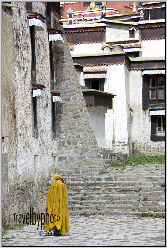 Meanwhile, it has become very sunny. Ingrid's ear is a lot better. No more pain!
Meanwhile, it has become very sunny. Ingrid's ear is a lot better. No more pain!
There is a preponderance of Chinese people here. Even the souvenir sales is largely in the hands of the Chinese.
In the afternoon we walk around the market and buy some little things. Near the bus station are a lot of people drinking on the street. They come from the surrounding villages and are waiting for their bus. Meanwhile they kill the time by drinking liberally own brewed liquors. It doesn't look healthy. We politely pass the offer to come and sit with them and have a drink.
Around 9 am we go on stage. Today we drive to Sakya (4300 m). A devastatingly beautiful ride through the mountains. The mountains are rugged and bare. In the valleys the people working on the land. Barley and potatoes are mainly cultivated here. Here a lot of yaks again but no cows. The weather is fine: plenty of sun and some clouds.
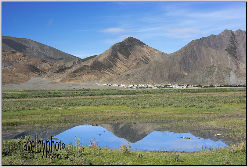
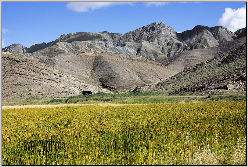
The first stop en route is mandatory. We have driven to fast so we have to wait 23 minutes before we can continue our tour and pass the police post. No problem; It is so beautiful here . We enjoy ourselves. The mountains reflect in the water and there are many little villages in the distance.
Then we can move on across the Tsa La (4950 m) mountain pas. At our request, we stop just in a random village along the road. We walk through the village. The houses are traditionally built. Humans and animals under the same roof. Each on its own floor.
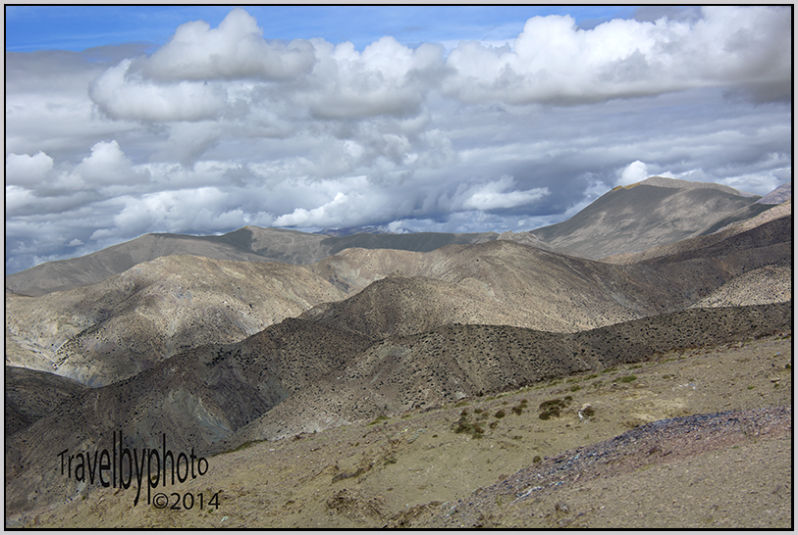
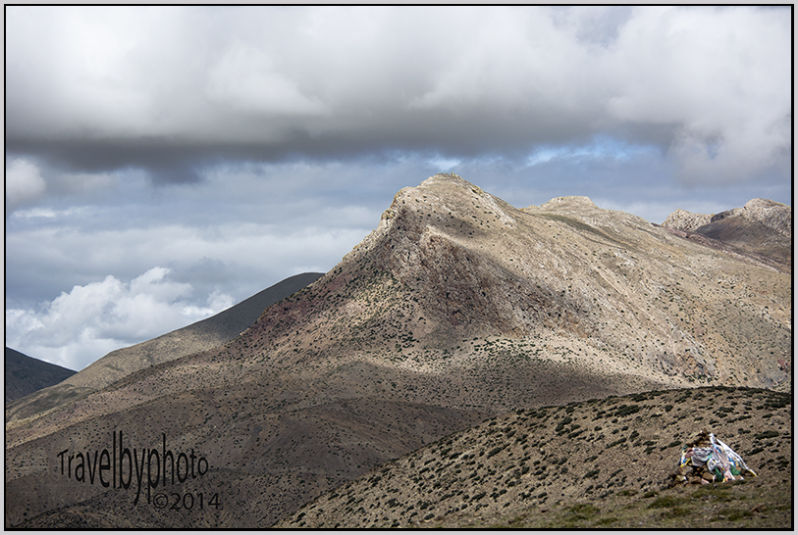
Everywhere drying cow dung. Sufficient fuel for the stove here.
We drive to Sakya. Sakya is a very nice town between the mountains. The city has always had a special position in Tibet. In the 14th century, this region was declared independent and even today the region is strikingly untouched by China.
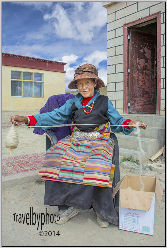
The city spans a river. Across the river, the houses and a monastery (not the present head monastery) are posted against the mountainside.
We have a good hotel. The Manasarovar Sakya Hotel. Good rooms and a nice restaurant where we have a tasty lunch. There are next to us no other western tourists in the hotel. We even seem to be the only western tourists in town.
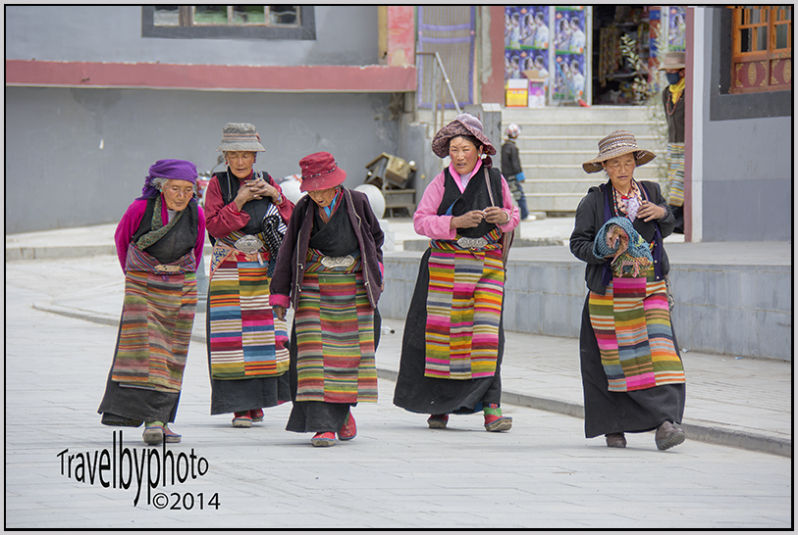
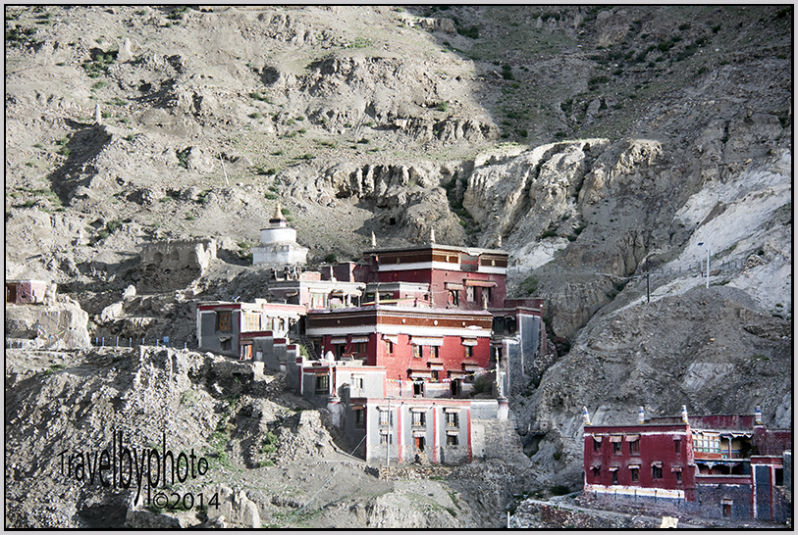
We walk into town. Very different, but again, very special and nice. The walls of the buildings are painted blue-gray and are decorated with red and white vertical lines. The red and white stripes stand for the Sakya Pa direction in Tibetan Buddhism.
Sakya is clearly a central municipality. From around the region, people come here to do some shopping and visit the monastery. Almost everyone is in original clothing. Brightly. Many women have hats on and they have colored ribbons twisted by their braids. Men wear their hair in a bun. they wear smocks with beautiful blue cuffs.
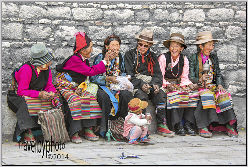
We see half a village climb in the back of a cart pulled by a tractor. Public transport. The tractor will transport the people back home after shopping-time. On the square in front of the monastery men sit together with pints of lager and home brewed drinks that look very strong! We fear that there will be a lot of alcohol abuse here !! Women tangled up together around a saleswoman of beautiful wool strands The women choose the wool carefully in nice color combinations. At home they make the well known Tibetan aprons. Almost all women wear a Tibetan apron as part of their traditional costume.
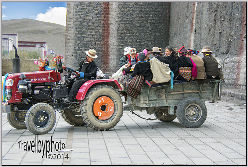
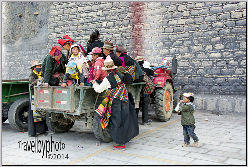
We walk through narrow streets. Between the houses that are covered with cow dung . Whole piles of dried dung lay at the edges of walls and on rooftops. Nice vistas.
In the afternoon we come together for a drink. We don't drink much alcohol, as we sit here at 4300 meters altitude. It is not cold at all. Even for a sweater during the day it is to hot. Sure different than last year when we were in Arunachal Pradesh.
We have breakfast in the dining room of the hotel.
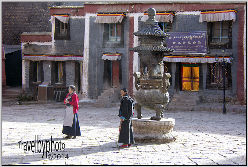
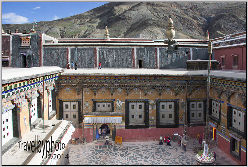
After breakfast we leave the hotel for a visit to the Sakya monastery. We have already seen a lot of monasteries during this trip. Every monastery is unique and this one is no exception. Very special. An old monk sitting on his throne softly blows at a conch. Pilgrims parade past him.
Via a steep stairs we arrive on the roof. Upstairs is a patrol circuit; a circuit where you have a nice view at the surroundings
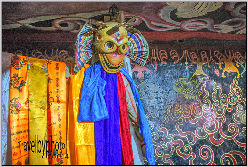
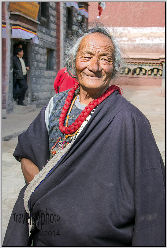
In the northeast corner of the tour is a special chapel dedicated to the "protectors". Inside the chapel it's dark. The only light comes from the strong smelling smoky oil lamps. In the corner of the chapel stores a monk monotonically on the drum. Intimidating images of the guards and other characters look at you menacingly, images of chopped hands and feet, a yak, a tiger . It looks more like a horror chamber than a chapel. Fascinating though!
The chapels down are once again filled with beautiful Buddha images. It creates a very serene atmosphere. We stabbing a candle for Maarten and our other loved ones. We learn about how to practice the candle ceremony properly. You have to tackle the wick with a special tongs. Then you have to light the candle with the wick in the tongs. When finished the wick should go out with a quick hand movement.
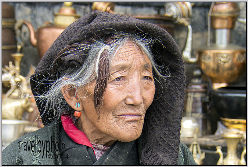
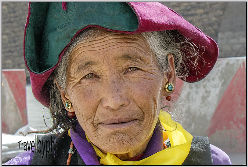 A lot of people in traditional dress again. The monks are getting ready for the service. Laden with drums, dress, horns, cymbals and other religious attributes they descend from their cells to the temple. Unfortunately we do not have enough time to experience a part of the service. We skip A visit to the famous library because we still have a long travel day ahead.
A lot of people in traditional dress again. The monks are getting ready for the service. Laden with drums, dress, horns, cymbals and other religious attributes they descend from their cells to the temple. Unfortunately we do not have enough time to experience a part of the service. We skip A visit to the famous library because we still have a long travel day ahead.
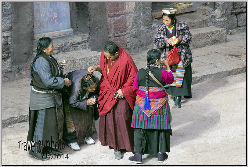
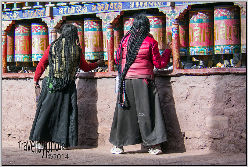
After visiting the monastery we take the car and hit the road again. Today is a full day with (literally) highlights. Many beautiful mountain vistas with fascinating changing cloud formations.
We pass Gyatso Pass (5220 meters altitude). An old woman sits purring for her hut. From here we have a first view of the highest mountains in the world. There is virtually no snow here. We understand that even during wintertime snow is modest here. But the winters are always very cold and there will be a stormy wind most off the time. But today we have excellent temperatures.
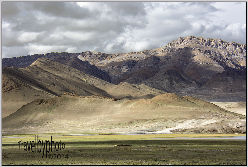
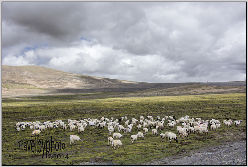
After the pass our car flips on the road. The car get stuck in a pothole. When the car is finally loose and the damage is inspected it goes totally wrong again with the driver. He drifts the car from left to right across the road and after we almost crashed a truck that was coming towards us, our patience it at an end. We stop the car.
Pierre takes over the steering wheel though it is not allowed to do that in Tibet. Pierre doesn't even have his driver's license with him. But necessity is the mother of invention. It's really irresponsible to let the driver drive on. He is much too sick! Sick as a dog he hangs at the backseat. Pierre will drive close to the next police station and then, after a short stop and a little refurbishing, Schering the driver will drive us past the checkpoint.
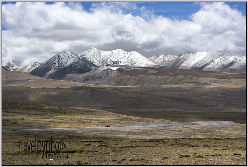
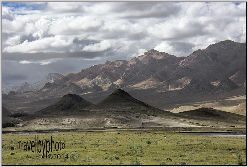
We reach the entrance of the Qomolangma Nature Preserve. We must all leave the car and walk to checkpoint. There we have to show our passports and buy an entrance ticket. Shortly after the police station is a small village (Shekar - New Tingri). We have lunch in an inn.
Schering has really turned blue now. He is stretched out on a couch, and gets a large pillow above his head, which is filled with oxygen. His lips and nails look blue. Scary. He has clearly a oxygen deficiency. A tube from the oxygen cushion is in his nose.
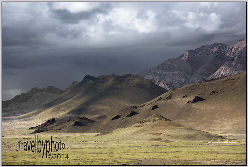
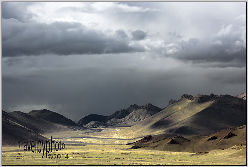
We call René, the Dutchman from Shigatse Travels in Lhasa where we have booked our trip. We explain the situation to him but he doesn't take us serious. A Tibetan driver with oxygen problems in the mountains; never heard of!. His reaction makes us angry. We call again and tell him not to downplay. Schering has the symptoms of severe altitude sickness and really should go down as soon as possible. An hour or two later 2 drivers arrive; one to drive Shering to a lower altitude and one to bring us further.
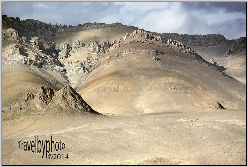
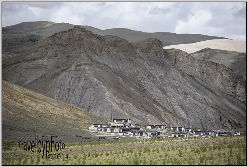
It is late when we finally set off for the final stretch. Incredibly beautiful mountains again. The valley here is wide, surrounded by snow capped mountains. We drive in the park where mountain peaks as Mount Everest, Lhotse, Makalu and Cho Oyu are situated. There are many sheep, yaks, donkeys.
Close to seven p.m., we arrive at our hotel in Tigri. The Ha Hoo hotel is a nice hotel with a large terrace. In the distance we can see beautiful snow peaks with clouds around it.
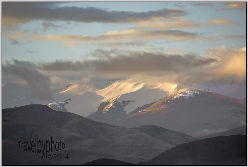
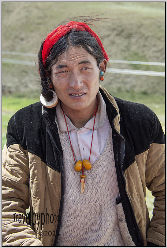
Hopefully tomorrow it will be bright. There is an overwhelming amount of wind! We eat modestly, but good. Not such a cozy restaurant as we usually are accustomed. But the room is fine and there is even WiFi in the lobby!